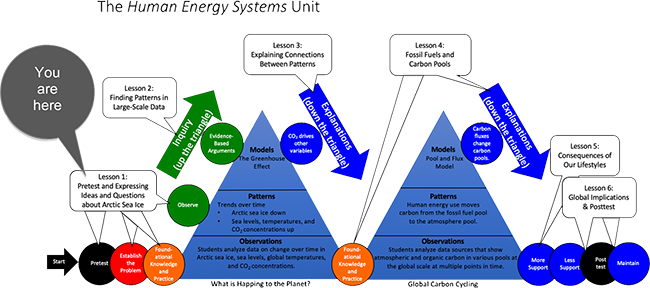Transformations in Matter and Energy Carbon TIME is an NSF-funded partnership led by Michigan State University
Human Energy Systems | Lesson 1 - Pretest and Expressing Ideas
Overview
Students take the unit pretest, practice how and why scientists construct graphs to represent data and construct a graph of arctic sea ice extent from 1979-2015 and identify a trend in the data: arctic sea ice is declining.
Guiding Question
What is happening to arctic sea ice?
Activities in this Lesson
- Activity 1.1: Human Energy Systems Unit Pretest (20 min)
- Activity 1.2: Expressing Ideas and Questions about Arctic Sea Ice (40 min)
- Activity 1.3: Graphing Arctic Sea Ice (45 min)
- Activity 1.4: Drawing a Trend Line (40 min)
- Activity 1.5: Finding a Trend in Arctic Sea Ice (40 min)
Unit Map

Target Student Performance
|
Activity |
Target Performance |
|
Lesson 1 – Pretest and Expressing Ideas about Arctic Sea Ice (students as questioners and investigators) |
|
|---|---|
|
Activity 1.1 Human Energy Systems Unit Pretest (20 min) |
Students show their initial proficiencies for the overall unit goals: 1. Questioning, investigating, and explaining how the Earth’s climate is changing 2. Explaining and predicting how carbon cycles and energy flows in Earth systems. |
|
Activity 1.2: Expressing Ideas and Questions about Arctic Sea Ice (40 min) |
Students express ideas and record questions about why Arctic sea ice seems to be shrinking. |
|
Activity 1.3: Graphing Arctic Sea Ice (45 min) |
Students use data on Arctic sea ice to construct graphs showing patterns in changing coverage over time. |
|
Activity 1.4: Drawing a Trend Line (40 min) |
Students use multi-year averages to construct a trend line using data on Lake Superior ice cover. |
|
Activity 1.5: Finding a Trend in Arctic Sea Ice Data (40 min) |
Students use multi-year averages to construct a trend line using data on Arctic sea ice. |
NGSS Performance Expectations
This lesson does not feature a mastery of any of the NGSS performance expectations but provides students with foundational practices and knowledge needed to master all of the performance expectations in the rest of the unit.

 Download PDF of Lesson 1 Teacher's Guide
Download PDF of Lesson 1 Teacher's Guide